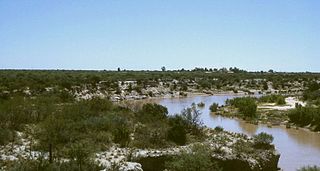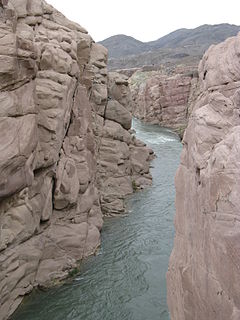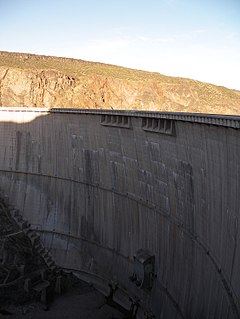The geography of Argentina describes the geographic features of Argentina, a country located in southern South America. Bordered by the Andes in the west and the South Atlantic Ocean to the east, neighboring countries are Chile to the west, Bolivia and Paraguay to the north, and Brazil and Uruguay to the northeast.

The Colorado River is a river in the south of Argentina.

San Juan is a province of Argentina, located in the western part of the country. Neighbouring provinces are, moving clockwise from the north, La Rioja, San Luis and Mendoza. It borders with Chile at the west.

The Paraná River is a river in south Central South America, running through Brazil, Paraguay, and Argentina for some 4,880 kilometres (3,030 mi). It is second in length only to the Amazon River among South American rivers. The name Paraná is an abbreviation of the phrase "para rehe onáva", which comes from the Tupi language and means "like the sea". It merges first with the Paraguay River and then farther downstream with the Uruguay River to form the Río de la Plata and empties into the Atlantic Ocean.

The Salado River is a river that crosses several provinces of Argentina, flowing 1,150 kilometres (710 mi) from its source in the Salta Province to end in the Paraná River, in the Santa Fe Province. Because its origin, its flow varies widely within the year, and it can dry out in some parts of its path during the winter. The only important tributary to the river is the Horcones River, which is born in Salta as Cajón River, and joins the Salado in the Santiago del Estero Province.

The Desaguadero River is a river in Argentina. Originating near the Tipas volcano in La Rioja at about 5,500 m (18,000 ft) elevation, the river is known in its upper reaches as the Bermejo or Vinchina. In its lower reaches it is also known as the Salado. It joins the Colorado River in La Pampa Province near Pichi Mahuida. The Desaguadero River has a total length of 1,498 km (931 mi) and its drainage basin is about 260,000 km2 (100,000 sq mi).

The Jáchal River is a river in the province of San Juan, Argentina. It is part of the Desaguadero River basin, and one of the most important permanent watercourses in the province, with an average flow of 9 cubic metres per second (320 cu ft/s). It is born from the confluence of the Río de la Palca and the Blanco River, in the northwest of San Juan.

The San Juan River is, together with the Jáchal, the most important river of the Argentine province of San Juan. Both join the Desaguadero/Colorado system that ends at the Atlantic Ocean.

The Mendoza River is a river in the province of Mendoza, Argentina. It is formed in the Andes range between the Aconcagua and the Tupungato, by the confluence of the Vacas, the Cuevas and the Tupungato rivers, the last being its major tributary.
The Tunuyán River is a river in the Argentine province of Mendoza. It is born in Mount Tupungato, in the Andes range, and flows initially to the northeast, passing by the city of Tunuyán. It is then dammed by the El Carrizal Dam, after which it turns east-southeast passing near the cities of Rivadavia, Santa Rosa and La Paz. Finally, it branches into the Tunuyán Nuevo (north) and Tunuyán Viejo (south), and empties into the Desaguadero River.

The Los Reyunos Dam is an embankment dam on the Diamante River, in central Mendoza Province, Argentina, some twenty-two miles from the city of San Rafael. The dam, built of stone and compacted clay to minimize execution and cost, is 440 feet high and contains a reservoir covering an area of 1,828 acres.

Water resources management (WRM) functions in Argentina are handled by multiple institutions operating at the national, provincial, and river basin level, with a variety of functions and jurisdictions. On the national level, the National Institute for Water and the Environment (INA) and the National Water and Sanitation Utility (AySA) are charged with the duties of researching, water resources preservation, developing services, and implementing water projects.

The Sierra de las Quijadas National Park is a national park located in the northwestern part of the Argentine province of San Luis. It was established on December 10, 1991, to protect the natural features, representative of the Semiarid Chaco and the Argentine Low Monte ecoregions.

The Agua del Toro Dam is an arch dam on the Diamante River about 63 kilometres (39 mi) west of San Rafael in Mendoza Province, Argentina. The primary purpose of the dam is hydroelectric power generation and it supports a 150 megawatts (200,000 hp) power station located downstream. Construction on the dam began in 1966 and it was completed in 1973. The power station was started the same year and commissioned in 1982. The dam and power station is part of the Rio Diamante System which is owned jointly by Hidroeléctrica Diamante (HIDISA) and Hidroeléctrica de los Nihuiles (HINISA).
Infiernillo is a volcanic field in Argentina. The field is located northwest of Malargue, at the Rio Salado. The volcanic field, part of the Southern Volcanic Zone, has formed three individual vents with associated lava flows.

The Argentine Monte (NT0802), or Low Monte, is an ecoregion of dry thorn scrub and grasslands in Argentina. It is one of the driest regions in the country. Human settlements are mainly near water supplies such as rivers or oases. Deforestation and over-grazing around these settlements have caused desertification.






















